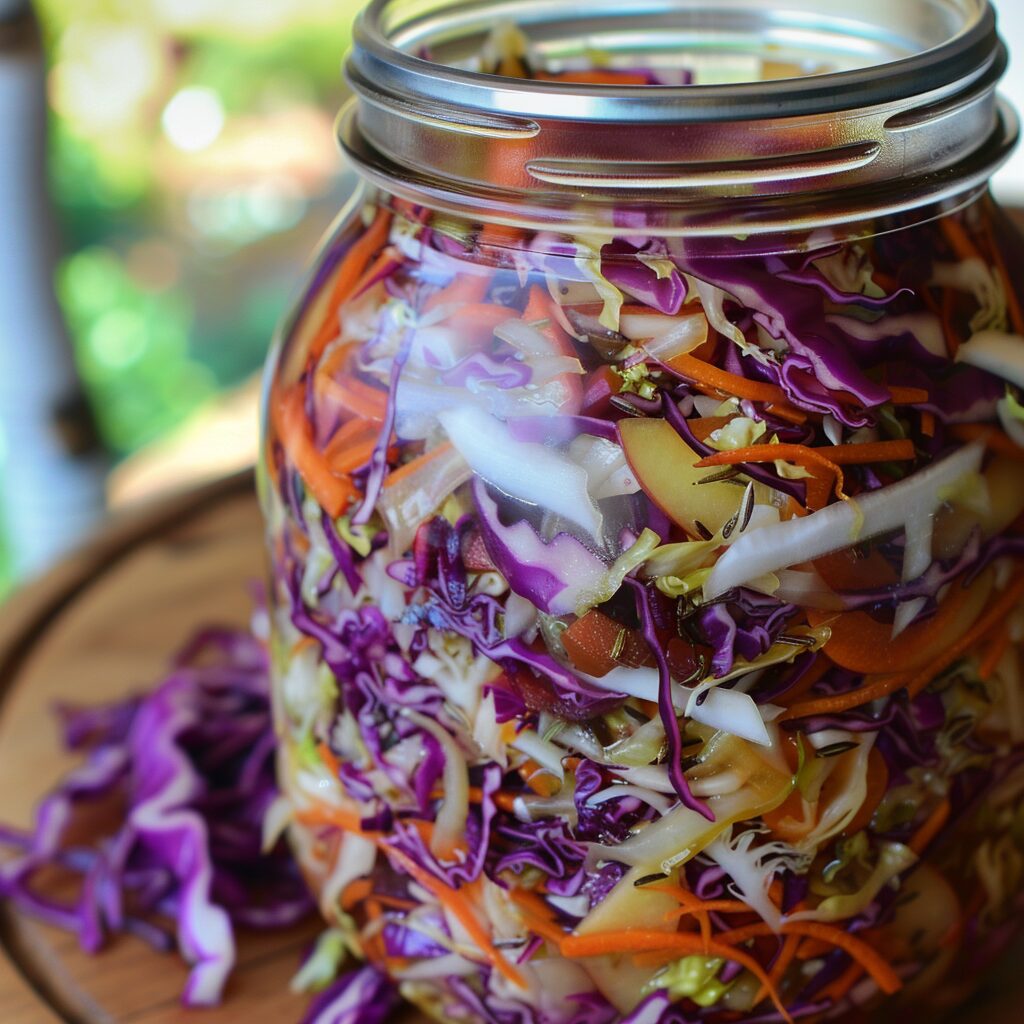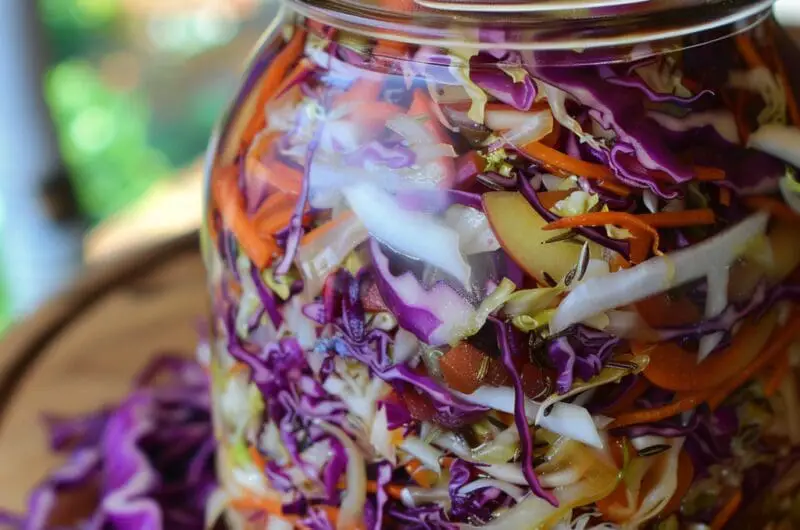Sauerkraut, a humble fermented cabbage dish, has been cherished across generations for its tangy flavor and health benefits. Today, we’re exploring some of the most unique ways to enjoy sauerkraut, guaranteed to impress even the most seasoned palates.
Transform Your Meals with Sauerkraut
While traditionally paired with sausages or pork, sauerkraut is breaking boundaries in the culinary world. Imagine sauerkraut blended into a smooth, creamy butter, perfect for spreading on a crusty baguette or melting over steamed vegetables. This creative twist not only enhances the flavor but also boosts the nutritional value of your meals.
Another groundbreaking preparation is sauerkraut beer, a novel beverage that marries the probiotic benefits of fermented cabbage with the refreshing zest of beer. This fusion creates a drink that’s not only unique but also good for your gut health.
Tip: Try adding a spoonful of flavored sauerkraut to your next smoothie for a tangy twist and a boost of probiotics.
Innovative chefs are incorporating sauerkraut into dishes like seafood sausages, where the sauerkraut is finely chopped and mixed with fresh seafood, herbs, and spices, then encased and cooked to perfection. The result is a delightful burst of oceanic flavors complemented by the tang of sauerkraut.
For those who enjoy a bit of crunch, consider sauerkraut-based savory beignets. These small, fried delights are perfect as an appetizer or a snack, combining the crispy exterior with a soft, tangy interior that’s utterly irresistible.
A New Look at Classic Dishes
The versatility of sauerkraut extends to reimagining classic dishes. Take the beloved Reuben sandwich, for instance. By using sauerkraut that has been mixed with beets or carrots, you introduce a vibrant color and a new layer of flavor to this New York deli classic.
Vegetarians can rejoice with the introduction of the Vegetarian Beet Reubens, where sauerkraut is paired with roasted beets and smothered in melty Swiss cheese, all nestled between slices of rye bread.
Tip: Enhance your sauerkraut dishes by selecting high-quality, non-reactive containers for fermentation to ensure the best flavor development.
Sauerkraut is also making a splash in the world of pizza toppings. Swap out traditional toppings for a sauerkraut mixture with smoked sausage and a sprinkle of caraway seeds for a pizza that is both rustic and refined.
And let’s not forget about sauerkraut in desserts. A sauerkraut-infused chocolate cake offers a surprisingly delightful tang that balances the sweetness of the chocolate, providing a complex flavor profile that is sure to intrigue any dessert lover.
Health Benefits That Impress
Beyond its flexibility in recipes, sauerkraut boasts a wealth of health benefits. It’s rich in vitamins C and K, fiber, and antioxidants, and it’s a probiotic powerhouse that supports gut health. Integrating sauerkraut into your diet can help improve digestion, boost the immune system, and may even aid in weight loss.
With the growing trend of fermented foods, sauerkraut is also recognized for its potential to reduce health risks such as heart disease and certain cancers. Its low calorie count makes it an excellent choice for those monitoring their weight.
Tip: For those new to fermenting at home, consider using a starter culture to ensure a successful fermentation process and the best probiotic benefits.
The rising popularity of sauerkraut in various dishes from breakfast to dessert illustrates its versatility and appeal. Whether you’re a culinary expert or a home cooking enthusiast, experimenting with sauerkraut can open up a whole new world of flavors and benefits.
Embrace the renaissance of sauerkraut in your cooking repertoire and discover just how diverse this traditional ingredient can be. From its roots in Eastern European cuisine to its place in modern gastronomy, sauerkraut continues to surprise and delight the palates of food lovers around the world.
So, next time you think about sauerkraut, remember that it’s not just for topping hot dogs. With a bit of creativity, this age-old favorite can transform into something truly spectacular, providing taste experiences you’ve never imagined before.
Colorful Sauerkraut Medley
Course: Side DishCuisine: German4
servings30
minutes40
minutes300
kcal70
minutesDiscover how to elevate your dishes with this colorful and tangy sauerkraut medley, perfect for any culinary enthusiast looking to explore fermented foods.
Ingredients
1 large head red cabbage, thinly sliced
3 medium carrots, grated
2 apples, cored and sliced
1 tablespoon caraway seeds
2 teaspoons salt
4 cups water
1 tablespoon apple cider vinegar
1 teaspoon juniper berries, optional
Directions
- Combine the red cabbage, carrots, apples, and caraway seeds in a large bowl. Mix them well to ensure the flavors meld together.
- In a separate bowl, dissolve the salt in water and vinegar to create your brine. Pour this mixture over your cabbage blend, ensuring all ingredients are submerged.
- Add juniper berries if using, then tightly pack the mixture into a fermentation jar. Use a weight to keep everything submerged under the brine, minimizing air exposure.
- Cover the jar with a cloth or airlock lid and let it ferment at room temperature for at least one week. Check daily to ensure that the vegetables remain submerged and to release any gases that form.
- After fermentation, taste the sauerkraut. If it has reached the desired sourness, transfer it to the refrigerator to halt fermentation and preserve its flavor.
Notes
- Ensure that your fermentation jar and tools are thoroughly cleaned to avoid contamination.
- The sauerkraut can be stored in the refrigerator for up to 6 months, ensuring it remains submerged in brine.
- Adjust the amount of salt and vinegar based on your taste and the volume of vegetables.
Frequently Asked Questions about Sauerkraut
Q: How long does homemade sauerkraut last?
A: Homemade sauerkraut can last up to 6 months in the refrigerator, as long as it’s kept submerged in its brine.
Q: Can sauerkraut be made without salt?
A: Salt is essential in sauerkraut fermentation as it inhibits the growth of undesirable bacteria while allowing lactic acid bacteria to thrive and ferment the cabbage.
Q: What are the health benefits of eating sauerkraut?
A: Sauerkraut is rich in probiotics, vitamins C and K, and fiber. It supports digestive health, boosts the immune system, and can help reduce the risk of certain diseases.
Q: Can I add other vegetables to my sauerkraut?
A: Yes, you can add a variety of vegetables like carrots, beets, and onions to your sauerkraut for different flavors and nutritional benefits.


